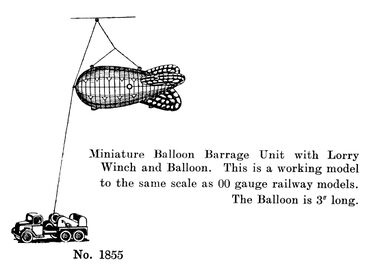Category:Observation and Barrage Balloons: Difference between revisions
No edit summary |
No edit summary |
||
| Line 1: | Line 1: | ||
{{Box|Scale_Model_Balloon_Barrage_with_Clockwork_Winch_Lorry,_Minic_(MM_1940-07).jpg|'''1940:''' Minic Barrage Balloon Set|380}} | {{Box|Scale_Model_Balloon_Barrage_with_Clockwork_Winch_Lorry,_Minic_(MM_1940-07).jpg|'''1940:''' Minic Barrage Balloon Set|380}} | ||
{{Box|Barrage_Balloon_Unit,_Britains_1855_(BritCat_1940).jpg|'''1940:''' the smaller Britains set, scaled for 00-gauge|380}} | |||
'''Observation Balloons''' and '''Barrage Balloons''' were usually based on a design known as a '''Kite Balloon'''. | '''Observation Balloons''' and '''Barrage Balloons''' were usually based on a design known as a '''Kite Balloon'''. | ||
Revision as of 19:23, 10 February 2023
1940: Minic Barrage Balloon Set [image info]
1940: the smaller Britains set, scaled for 00-gauge [image info]
Observation Balloons and Barrage Balloons were usually based on a design known as a Kite Balloon.
Completely or partly filled with hydrogen, this was a three-lobed inflatable balloon with three blobby inflated fins at the back, for stability. Designed to be tethered and to point into the wind, the tail fins looked childishly crude, but seem to have been effective.
Britain seems to have been a little slow to understand the advantages of the "Kite Balloon" design, and some of the early British barrage balloons were still using a simple spherical design, which made them more limited in the range of wind speeds in which they could be deployed.
Observation Balloons
An observation balloon could lift a camera with a remote shutter cable for photography, or (more often) a human observer. An observer hoisted aloft on an observation balloon on one side of a set of battle-lines would be able to see layouts of the opposition's trenches and other defences, which was obviously useful. However, this also meant that when one side saw the other sending an observer aloft, they had a strong incentive to send a plane to shoot it down (or shoot the observer before they could report back). The officers sent aloft apparently were unarmed or armed only with their service handgun. According to hearsay from World War One, officers sent up as observers had to be very nice to their ground crews ... if they treated them badly, and were hated, all the ground crew had to do was to be a little bit too slow in winching the balloon back down again when an enemy aircraft appeared, and their "officer problem" was solved...
Barrage Balloons
Barrage balloons were used both World Wars as low-level air defences against aircraft attacking a city, the principle being similar to the use of antisubmarine cables in waterways. A tethered balloon could dangle a number of cables, which, of an aircraft flew beneath and snagged a cable with its wing, it might be thrown into a spin, or with a large bimber, the weighted cable running over the wing surface at high speed could saw through the structure. the weight on cables could be due to the length of the cables themselves, or sometimes, for good measure, the equivalent of a landmine could be fitted to the cable, so that when a moving aircraft wing caught the cable, the explosives would ram upwards into the underside of the plane.
Although a pilot could avoid these cables simply by not flying beneath the balloons, ground crews could also string wires between balloons, and hang more cables from the linking cable. Being too good a pilot and flying between a pair of balloons at the maximum distance form both was liable to make you hit a central strung cable. Understandably, pilots assigned to bomb a target would be very unhappy to see barrage balloons deployed, especially for night raids.
- In World War One, barrage balloons were deployed at pretty much the maximum height for most aircraft.
- In World War Two, planes could fly above the maximum practical balloon height, which was limited by the weight (and therefore by the length of cable) that could be lifted. However, higher-flying planes could be shot down more easily by anti-aircraft guns, which had more trouble getting a "fix" on lower-altitude aircraft, due to the rate of change of angle of a plane flying past at high speed. This meant that barrage balloons still had a useful role to play, as well as being psychological deterrents.
Commercial models
In the UK, models of barrage balloons were made by Tri-Ang (Minic), Skybirds, and Britains Ltd. Because these toys were quite specialised, and only really made in the late 1930s in the buildup to WW2, and then discontinued in 1940, very few have survived, making them incredibly difficult to find in any kind of condition, let alone mint and boxed.
External links
Pages in category ‘Observation and Barrage Balloons’
The following 2 pages are in this category, out of 2 total.
Media in category ‘Observation and Barrage Balloons’
The following 9 files are in this category, out of 9 total.
- A three-lobed Kite Balloon (WBoA 4ed 1920).jpg 2,038 × 3,000; 1.21 MB
- Barrage Balloon Section, box lid (Britains 1749).jpg 967 × 2,400; 550 KB
- Barrage Balloon Unit, Britains 1855 (BritCat 1940).jpg 2,220 × 1,585; 201 KB
- Instructions for Assembling the Barrage Balloon, p1 (Britains 1749).jpg 2,040 × 2,400; 736 KB
- Instructions for Assembling the Barrage Balloon, p2 (Britains 1749).jpg 2,043 × 2,400; 766 KB
- Observation balloon above a town (WBoA 4ed 1920).jpg 3,000 × 2,298; 1.96 MB
- Observation Balloon Ascending (WBoA 4ed 1920).jpg 3,000 × 2,354; 1.67 MB
- Scale Model Balloon Barrage with Clockwork Winch Lorry, Minic (MM 1940-07).jpg 2,816 × 3,000; 609 KB
- Underslung Lorry with Driver (Britains 1641).jpg 2,400 × 835; 618 KB











